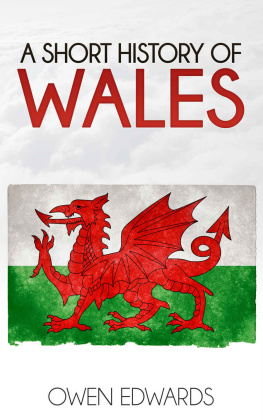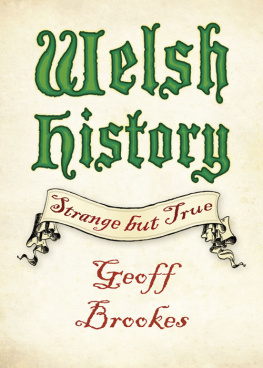A Short History of Wales
By Owen Edwards
Table of Contents
A Short History of Wales by Owen Edwards. First published in 1906. This edition published 2016 by Enhanced Media.
CHAPTER I: WALES
Wales is a row of hills, rising between the Irish Sea on the west and the English plains on the east. If you come from the west along the sea, or if you cross the Severn or the Dee from the east, you will see that Wales is a country all by itself. It rises grandly and proudly. If you are a stranger, you will think of it as Walesa strange country; if you are Welsh, you will think of it as Cymrua land of brothers.
The geologist will tell you how Wales was made; the geographer will tell you what it is like now; the historian will tell you what its people have done and what they are. All three will tell you that it is a very interesting country.
The rocks of Wales are older and harder than the rocks of the plains; and as you travel from the south to the north, the older and harder they become. The highest mountains of Wales, and some of its hills, have crests of the very oldest and hardest rockgranite, porphyry, and basalt; and these rocks are given their form by fire. But the greater part of the country is made of rocks formed by waterstill the oldest of their kind. In the north-west, centre, and westabout two-thirds of the whole country,the rocks are chiefly slate and shale; in the south-east they are chiefly old red sandstone; in the north-east, but chiefly in the south, they are limestone and coal.
Its rocks give Wales its famous sceneryits rugged peaks, its romantic glens, its rushing rivers. They are also its chief wealthgranite, slate, limestone, coal; and lodes of still more precious metalsiron, lead, silver, and goldrun through them.
The highest mountain in Wales is Snowdon, which is 3,570 feet above the level of the sea. For every 300 feet we go up, the temperature becomes one degree cooler. At about 1,000 feet it becomes too cold for wheat; at about 1,500 it becomes too cold for corn; at about 2,000 it is too cold for cattle; mountain ponies graze still higher; the bleak upper slopes are left to the small and valuable Welsh sheep.
There are three belts of soil around the hillsarable, pasture, and sheep-runone above the other. The arable land forms about a third of the country; it lies along the sea border, on the slopes above the Dee and the Severn, and in the deep valleys of the rivers which pierce far inland,the Severn, Wye, Usk, Towy, Teivy, Dovey, Conway, and Clwyd. The pasture land, the land of small mountain farms, forms the middle third; it is a land of tiny valleys and small plains, ever fostered by the warm, moist west wind. Above it, the remaining third is stormy sheep-run, wide green slopes and wild moors, steep glens and rocky heights.
From north-west to south-east the line of high hills runs. In the north-west corner, Snowdon towers among a number of heights over 3,000 feet. At its feet, to the north-west, the isle of Anglesey lies. The peninsula of Lleyn, with a central ridge of rock, and slopes of pasture lands, runs to the south-west. To the east, beyond the Conway, lie the Hiraethog mountains, with lower heights and wider reaches; further east again, over the Clwyd, are the still lower hills of Flint.
To the south, 30 miles as the crow flies, over the slate country, the Berwyns are seen clearly. From a peak among theseCader Vronwen (2,573 feet), or the Aran (2,970 feet), or Cader Idris (2,929 feet)we look east and south, over the hilly slopes of the upper Severn country.
Another 30 miles to the south rises green Plinlimmon (2,469 feet); from it we see the high moorlands of central Wales, sloping to Cardigan Bay on the west and to the valley of the Severn, now a lordly English river, on the east.
Forty miles south the Black Mountain (2,630 feet) rises beyond the Wye, and the Brecon Beacons (2,910 feet) beyond the Usk. West of these the hills fade away into the broad peninsula of Dyved. Southwards we look over hills of coal and iron to the pleasant sea-fringed plain of Gwent.
On the north and the west the sea is shallow; in some places it is under 10 fathoms for 10 miles from the shore, and under 20 fathoms for 20 miles. Tales of drowned lands are toldof the sands of Lavan, of the feast of drunken Seithenyn, and of the bells of Aberdovey. But the sea is a kind neighbour. Its soft, warm winds bathe the hills with life; and the great sweep of the big Atlantic waves into the river mouths help our commerce. Holyhead, Milford Haven, Swansea, Newport, Barry, and Cardiffnow one of the chief ports of the worldcan welcome the largest vessels afloat. The herring is plentiful on the west coast, and trout and salmon in the rivers.
CHAPTER II: THE WANDERING NATIONS
By land and by sea, race after race has come to make the hills of Wales its home. One race would be short, with dark eyes and black hair; another would be tall, with blue eyes and fair hair. They came from different countries and along different paths, but each race brought some good with it. One brought skill in taming animals, until it had at last tamed even the pig and the bee; another brought iron tools to take the place of stone ones. Another brought the energy of the chase and war, and another a delight in sailing a ship or in building a fortress.
One thing they had in commonthey wandered, and they wandered to the west. From the cold wastes and the dark forests of the north and east, they were ever pushing west to more sunny lands. As far back as we can see, the great migration of nations to the west was going on. The islands of Britain were the furthest point they could reach; for beyond it, at that time, no man had dared to sail into the unknown expanse of the ocean of the west. In the islands of Britain, the mountains of Wales were among the most difficult to win, and it was only the bravest and the hardiest that could make their home among them.
The first races that came were short and dark. They came in tribes. They had tribal marks, the picture of an animal as a rule; and they had a strange fancy that this animal was their ancestor. It may be that the local nicknames which are still rememberedsuch as the pigs of Anglesey, the dogs of Denbigh, the cats of Ruthin, the crows of Harlech, the gadflies of Mawddwywere the proud tribe titles of these early people. Their weapons and tools were polished stone; their hammers and hatchets and adzes, their lance heads and their arrow tips, were of the hardest igneous rockchipped and ground with patient labour.
The people who come first have the best chance of staying, if only they are willing to learn; hardy plants will soon take the place of tender plants if left alone. The short dark people are still the main part, not only of the Welsh, but of the British people. It is true that their language has disappeared, except a few place-names. But languages are far more fleeting than races. The loss of its language does not show that a race is dead; it only shows that it is very anxious to change and learn. Some languages easily give place to others, and we say that the people who speak these languages are good linguists, like Danes and Slavs. Other languages persist, those who speak them are unwilling to speak any new language, and this is the reason why Spanish and English are so widespread.
After the short dark race came a tall fair-haired people. They came in families as well as in tribes. They had iron weapons and tools, and the short dark people could not keep them at bay with their bone-tipped spears and flint-headed arrows. We know nothing about the struggle between them. But it may be that the fairy stories we were told when children come from those far-off times. If a fairy maiden came from lake or mound to live among men, she vanished at once if touched with iron. Is this, learned men have asked, a dim memory of the victory of iron over stone?
Next page









